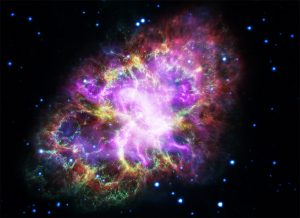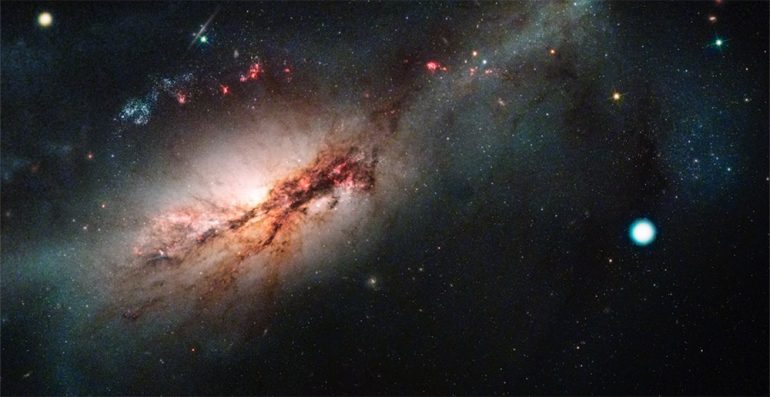Proven after 40 years: Astronomers have observed an electron capture supernova for the first time – a third, so far only theoretically predicted type of stellar explosion. A star collapses because its extreme gravity forces the electrons inside it into the atomic nucleus. This type of supernova may also explain how the famous Crab Nebula was formed—the remnant of a star explosion that was still visible in the sky during the day in 1054.
So far two main types of star explosions are known. Massive stars greater than ten solar masses explode at the end of their life cycle in a so-called core collapse supernova. The radiation pressure due to reduced nuclear fusion is no longer enough to compensate for the enormous force of gravity, the core collapses and an explosion occurs. a Supernova Vom Type Ia On the other hand occurs in binary star systems with a white dwarf. This remnant of a star up to eight solar masses sucks material from its companion until a threshold is reached and the white dwarf explodes.

What happens to the stars in between?
However, it is not yet clear what happens to stars whose mass is exactly between eight and ten solar masses. These stars are too heavy to become white dwarfs, but not so heavy that nuclear fusion can continue until iron atoms are formed – as is the case with nuclear collapse stars. At this point, a supernova shape postulated by Japanese astrophysicist Kenichi Nomoto about 40 years ago comes into play – the electro-capture supernova.
According to this theory, these stellar explosions are accompanied by so-called super AGB stars – red giants whose core consists mainly of oxygen, neon and magnesium. As nuclear fusion stops at this point, the pressure inside increases so much that electrons are trapped in the atomic nucleus. This process, known as electron capture, causes the nucleus to become unstable and explode in a supernova. So much for theory. So far, however, no evidence of observational evidence has been found for this type of supernova.
All the Characteristics of the Long-Sought Supernova Type
Now that has changed: For the first time ever, astronomers have discovered such an electron capture supernova in space. In March 2018, the first telescopes recorded a flash of the explosion in the outer region of a galaxy 31 million light-years away. Various other observatories on Earth and in orbit followed further development of Supernova 2018zd over two years.
A team led by Daiichi Hiramatsu from the Las Cumbres Observatory in California has now evaluated these data – and discovered several abnormalities. These include strong mass losses even before true supernovae, an unusual structure of the light spectrum, comparatively weak explosions, as well as short radioactive processes and nuclei rich in neutrons. “All of these properties of SN 2018zd can be explained by an electron capture supernova,” Hiramatsu says.
In addition, the team of astronomers was able to find previous star images by comparing them to older images from the Hubble and Spitzer space telescopes. These suggest that the preceding star is actually a super AGB star – a red giant with an unusual oxygen-neon core.
The “Missing Link” of Star Explosions
According to the research team, all this suggests that the 2018zd supernova is the third long-sought type of stellar explosion. “It was a real ‘eureka’ moment for us, which we can now help confirm a 40-year-old theory,” Hiramatsu says. The observations show for the first time that this type of explosion, which has long been postulated, is indeed present in stars – and thus closes the gap between core collapse and Ia supernovae.
“I am very pleased that the electron capture supernova has been discovered,” remarks the theory’s founder, Kenichi Nomoto. “This is a wonderful example of how theory and observation complement each other.”

Explanation for the Crab Nebula
Comments also shed new light on the famous Cancer Nebula – The glowing remnant of a supernova visible in the sky in the Middle Ages. This composition of glowing gases, about 6,300 light-years away, was created by the explosion of a star in 1054. According to records from Chinese astronomers, this supernova was visible in the sky for 23 days a day, and continued to glow at night for two years after the explosion.
But although the remnants of this supernova are the best studied of all, it is debated what kind of stellar explosion it caused. Knowledge gained from the 2018zd supernova, however, now helps to specify some previously difficult-to-interpret features of the Crab Nebula and suggests that it was also formed by an electron-capturing supernova.
“The term ‘Rosetta stone’ is often used as an analogy, but in this case it really fits,” says co-author Andrew Howell of the Las Cumbres Observatory. “Because supernova 2018zd is now helping us decode thousands of year-old records around the world. And it helps us connect to an event we didn’t understand before, the Crab Nebula, a well-liked one like this supernova.” With the phenomenon documented from.” (Nature Astronomy, doi:10.1038/s41550-021-01384-2)
Quayle: Las Cumbres Observatory Global Telescope, University of California – Davis

Internet fan. Alcohol expert. Beer ninja. Organizer. Certified tv specialist. Explorer. Social media nerd.





